2023 SUBARU BRZ light
[x] Cancel search: lightPage 338 of 432
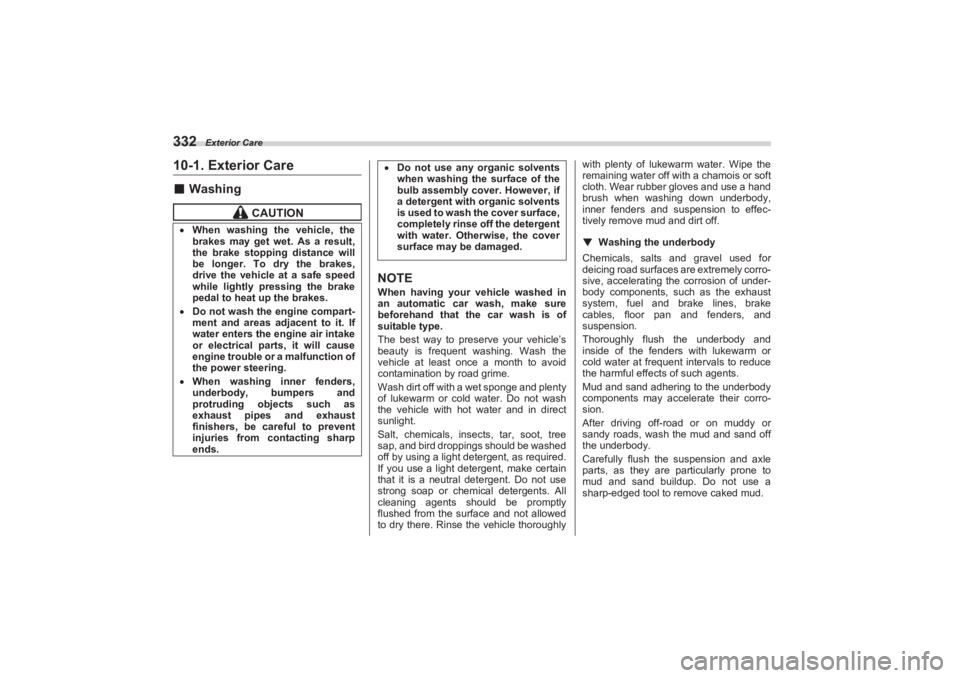
Exterior Care
33210-1. Exterior Care■Washing
NOTE
When having your vehicle washed in
an automatic car wash, make sure
beforehand that the car wash is of
suitable type.
The best way to preserve your vehicle’s
beauty is frequent washing. Wash the
vehicle at least once a month to avoid
contamination by road grime.
Wash dirt off with a wet sponge and plenty
of lukewarm or cold water. Do not wash
the vehicle with hot water and in direct
sunlight.
Salt, chemicals, insects, tar, soot, tree
sap, and bird droppings should be washed
off by using a light detergent, as required.
If you use a light detergent, make certain
that it is a neutral detergent. Do not use
strong soap or chemical detergents. All
cleaning agents should be promptly
flushed from the surface and not allowed
to dry there. Rinse the vehicle thoroughly with plenty of lukewarm water. Wipe the
remaining water off with a chamois or soft
cloth. Wear rubber gloves and use a hand
brush when washing down underbody,
inner fenders and suspension to effec-
tively remove mud and dirt off.
▼ Washing the underbody
Chemicals, salts and gravel used for
deicing road surfaces are extremely corro-
sive, accelerating the corrosion of under-
body components, such as the exhaust
system, fuel and brake lines, brake
cables, floor pan and fenders, and
suspension.
Thoroughly flush the underbody and
inside of the fenders with lukewarm or
cold water at frequent intervals to reduce
the harmful effects of such agents.
Mud and sand adhering to the underbody
components may accelerate their corro-
sion.
After driving off-road or on muddy or
sandy roads, wash the mud and sand off
the underbody.
Carefully flush the suspension and axle
parts, as they are particularly prone to
mud and sand buildup. Do not use a
sharp-edged tool to remove caked mud.
CAUTION
When washing the vehicle, the
brakes may get wet. As a result,
the brake stopping distance will
be longer. To dry the brakes,
drive the vehicle at a safe speed
while lightly pressing the brake
pedal to heat up the brakes. Do not wash the engine compart-
ment and areas adjacent to it. If
water enters the engine air intake
or electrical parts, it will cause
engine trouble or a malfunction of
the power steering. When washing inner fenders,
underbody, bumpers and
protruding objects such as
exhaust pipes and exhaust
finishers, be careful to prevent
injuries from contacting sharp
ends.
Do not use any organic solvents
when washing the surface of the
bulb assembly cover. However, if
a detergent with organic solvents
is used to wash the cover surface,
completely rinse off the detergent
with water. Otherwise, the cover
surface may be damaged.
BRZ_U.book 332 ページ 2022年3月29日 火曜日 午後3時59分
Page 339 of 432

Exterior Care
333
Appearance Care10
– CONTINUED –
▼Using a warm water washer
Keep a good distance of 12 in (30 cm)
or more between the washer nozzle and
the vehicle.
Do not wash the same area continu-
ously.
If a stain will not come out easily, wash
by hand. Some warm water washers are
of the high temperature, high pressure
type, and they can damage or deform the
resin parts such as moldings, or cause
water to leak in to the vehicle.■Waxing and PolishingAlways wash and dry the vehicle before
waxing and polishing.
Use a good quality polish and wax and
apply them according to the manufac-
turer’s instructions. Wax or polish when
the painted surface is cool. Be sure to polish and wax the chrome trim,
as well as the painted surfaces. Loss of
wax on a painted surface leads to loss of
the original luster and also quickens the
deterioration of the surface. It is recom-
mended that a coat of wax be applied at
least once a month, or whenever the
surface no longer repels water.
If the appearance of the paint has dimin-
ished to the point wher e the luster or tone
cannot be restored, lightly polish the
surface with a fine-grained compound.
Never polish just the affected area, but
include the surrounding area as well.
Always polish in only one direction. A No.
2000 grain compound is recommended.
Never use a coarse-grained compound.
Coarser grained compounds have a
smaller grain-size number and could
damage the paint. After polishing with a
compound, coat with wax to restore the
original luster. Frequent polishing with a
compound or an incorrect polishing tech-
nique will result in removing the paint layer
and exposing the undercoat. When in
doubt, it is always best to contact your
SUBARU dealer or an auto paint
specialist.
NOTEBe careful not to block the windshield
washer nozzles with wax when waxing
the vehicle.■ Cleaning Alloy WheelsPromptly wipe the alloy wheels clean of
any kind of grime or agent. If dirt is left on
too long, it may be difficult to clean off.
Do not use soap containing grit to clean
the wheels. Be sure to use a neutral
cleaning agent, and later rinse thoroughly
with water. Do not clean the wheels with a
stiff brush or expose them to a high-speed
washing device.
Clean the vehicle (including the alloy
wheels) with water as soon as possible
when it has been splashed with sea water,
exposed to sea breezes, or driven on
roads treated with salt or other agents.
CAUTION
Be careful not to damage brake
hoses, sensor harnesses, and
other parts when washing
suspension components. Be careful not to flush the engine
bottom for a long time. It may
cause damage of some electrical
parts.
CAUTION
Do not use any agents with organic
solvents on the surface of the bulb
assembly cover. However, if a pol-
ish or wax with organic solvents is
applied to the cover surface, com-
pletely wipe off the polish or wax.
Otherwise, the cover surface may
be damaged.
BRZ_U.book 333 ページ 2022年3月29日 火曜日 午後3時59分
Page 341 of 432
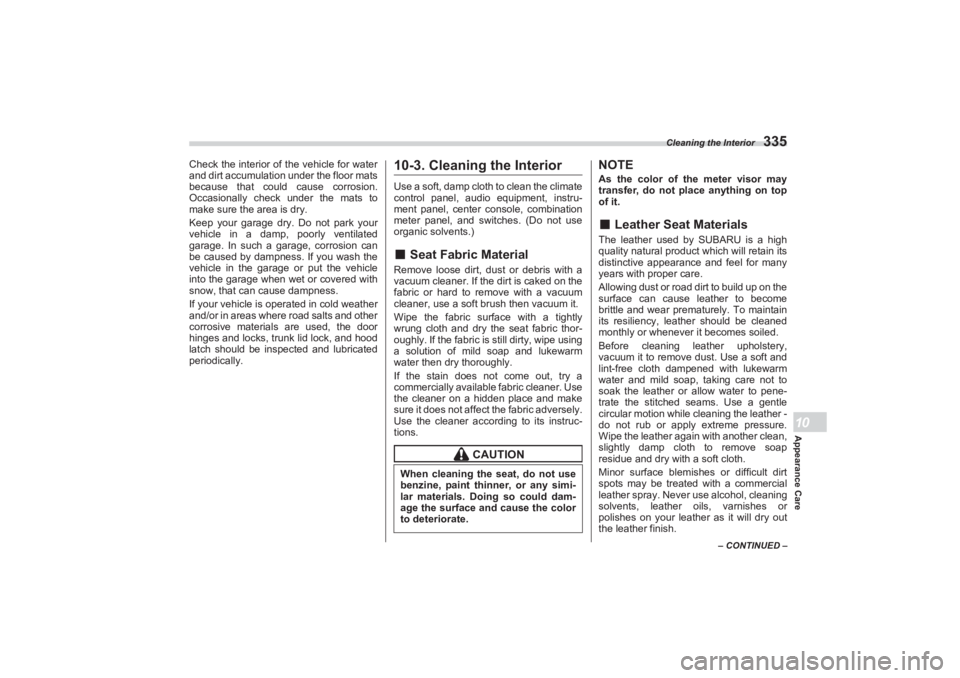
Cleaning the Interior
335
Appearance Care10
– CONTINUED –
Check the interior of the vehicle for water
and dirt accumulation under the floor mats
because that could cause corrosion.
Occasionally check under the mats to
make sure the area is dry.
Keep your garage dry. Do not park your
vehicle in a damp, poorly ventilated
garage. In such a garage, corrosion can
be caused by dampness. If you wash the
vehicle in the garage or put the vehicle
into the garage when wet or covered with
snow, that can cause dampness.
If your vehicle is operated in cold weather
and/or in areas where road salts and other
corrosive materials are used, the door
hinges and locks, trun k lid lock, and hood
latch should be inspected and lubricated
periodically.
10-3. Cleaning the InteriorUse a soft, damp cloth to clean the climate
control panel, audio equipment, instru-
ment panel, center console, combination
meter panel, and switches. (Do not use
organic solvents.)■ Seat Fabric MaterialRemove loose dirt, dust or debris with a
vacuum cleaner. If the dirt is caked on the
fabric or hard to remove with a vacuum
cleaner, use a soft brush then vacuum it.
Wipe the fabric surface with a tightly
wrung cloth and dry the seat fabric thor-
oughly. If the fabric is still dirty, wipe using
a solution of mild soap and lukewarm
water then dry thoroughly.
If the stain does not come out, try a
commercially available fabric cleaner. Use
the cleaner on a hidden place and make
sure it does not affect the fabric adversely.
Use the cleaner according to its instruc-
tions.
NOTEAs the color of the meter visor may
transfer, do not place anything on top
of it.■ Leather Seat MaterialsThe leather used by SUBARU is a high
quality natural product which will retain its
distinctive appearance and feel for many
years with proper care.
Allowing dust or road dirt to build up on the
surface can cause leather to become
brittle and wear prematurely. To maintain
its resiliency, leather should be cleaned
monthly or whenever it becomes soiled.
Before cleaning leather upholstery,
vacuum it to remove dust. Use a soft and
lint-free cloth dampened with lukewarm
water and mild soap, taking care not to
soak the leather or allow water to pene-
trate the stitched seams. Use a gentle
circular motion while cleaning the leather -
do not rub or apply extreme pressure.
Wipe the leather again with another clean,
slightly damp cloth to remove soap
residue and dry with a soft cloth.
Minor surface blemishes or difficult dirt
spots may be treated with a commercial
leather spray. Never use alcohol, cleaning
solvents, leather oils, varnishes or
polishes on your leather as it will dry out
the leather finish.
CAUTION
When cleaning the seat, do not use
benzine, paint thinner, or any simi-
lar materials. Doing so could dam-
age the surface and cause the color
to deteriorate.
BRZ_U.book 335 ページ 2022年3月29日 火曜日 午後3時59分
Page 342 of 432
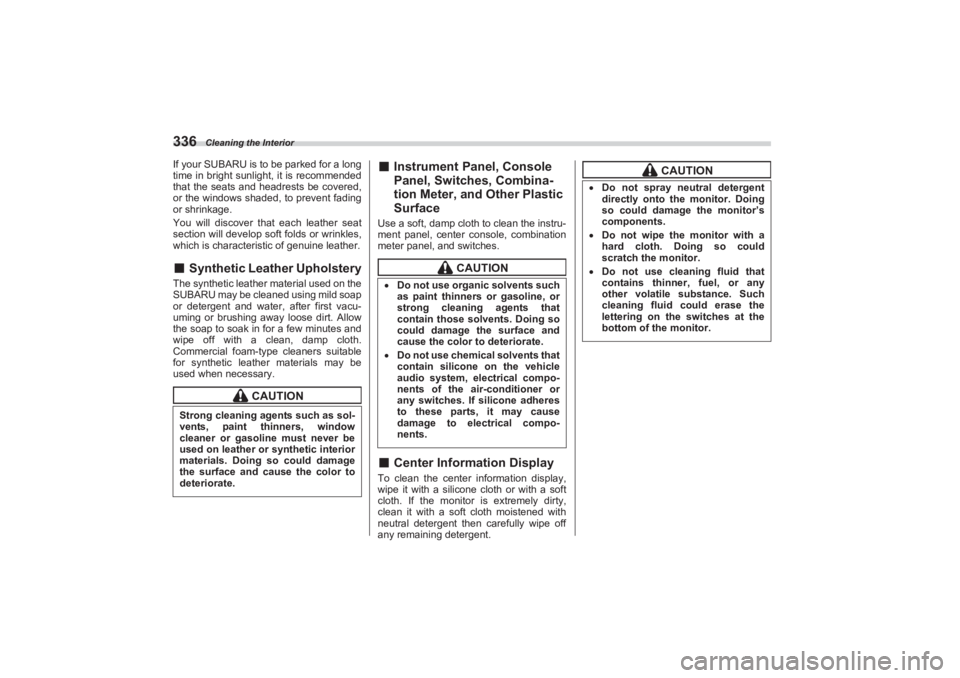
Cleaning the Interior
336If your SUBARU is to be parked for a long
time in bright sunlight, it is recommended
that the seats and headrests be covered,
or the windows shaded, to prevent fading
or shrinkage.
You will discover that each leather seat
section will develop so ft folds or wrinkles,
which is characteristic of genuine leather.■ Synthetic Leather UpholsteryThe synthetic leather material used on the
SUBARU may be cleaned using mild soap
or detergent and water, after first vacu-
uming or brushing away loose dirt. Allow
the soap to soak in for a few minutes and
wipe off with a clean, damp cloth.
Commercial foam-type cleaners suitable
for synthetic leather materials may be
used when necessary.
■ Instrument Panel, Console
Panel, Switches, Combina -
tion Meter, and Other Plastic
SurfaceUse a soft, damp cloth to clean the instru-
ment panel, center console, combination
meter panel, and switches.■ Center Information DisplayTo clean the center information display,
wipe it with a silicone cloth or with a soft
cloth. If the monitor is extremely dirty,
clean it with a soft cloth moistened with
neutral detergent then carefully wipe off
any remaining detergent.
CAUTION
Strong cleaning agents such as sol-
vents, paint thinners, window
cleaner or gasoline must never be
used on leather or synthetic interior
materials. Doing so could damage
the surface and cause the color to
deteriorate.
CAUTION
Do not use organic solvents such
as paint thinners or gasoline, or
strong cleaning agents that
contain those solvents. Doing so
could damage the surface and
cause the color to deteriorate. Do not use chemical solvents that
contain silicone on the vehicle
audio system, electrical compo-
nents of the air-conditioner or
any switches. If silicone adheres
to these parts, it may cause
damage to electrical compo-
nents.
CAUTION
Do not spray neutral detergent
directly onto the monitor. Doing
so could damage the monitor’s
components. Do not wipe the monitor with a
hard cloth. Doing so could
scratch the monitor. Do not use cleaning fluid that
contains thinner, fuel, or any
other volatile substance. Such
cleaning fluid could erase the
lettering on the switches at the
bottom of the monitor.
BRZ_U.book 336 ページ 2022年3月29日 火曜日 午後3時59分
Page 344 of 432
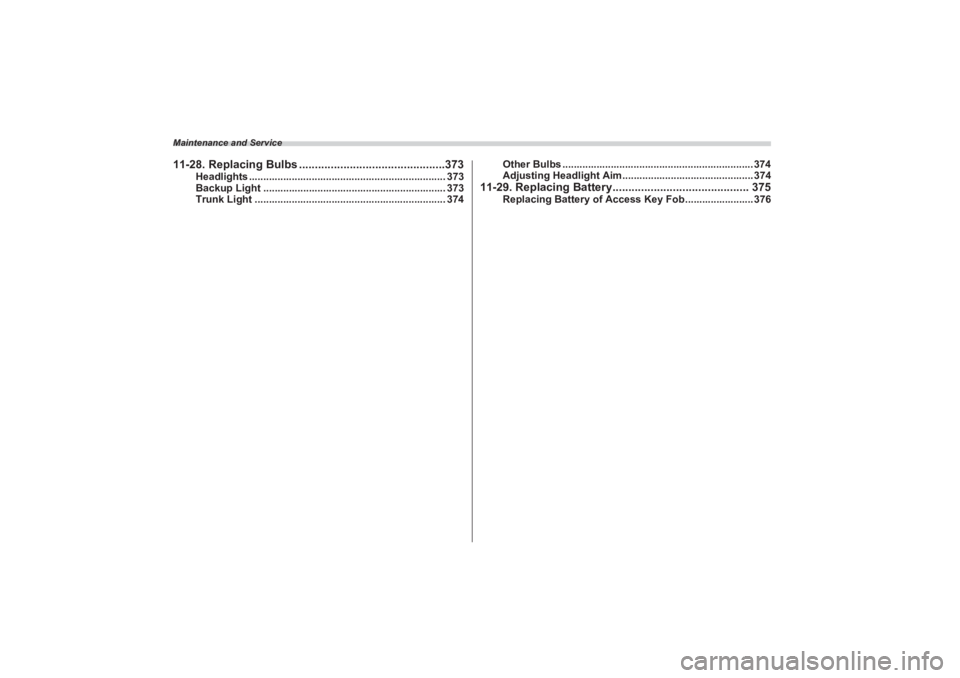
Maintenance and Service11-28. Replacing Bulbs ..............................................373
Headlights ..................................................................... 373
Backup Light ................................................................ 373
Trunk Light ................................................................... 374Other Bulbs ................................................................... 374
Adjusting Headlight Aim.............................................. 374
11-29. Replacing Battery........................................... 375
Replacing Battery of Access Key Fob........................ 376
BRZ_U.book 338 ページ 2022年3月29日 火曜日 午後3時59分
Page 350 of 432
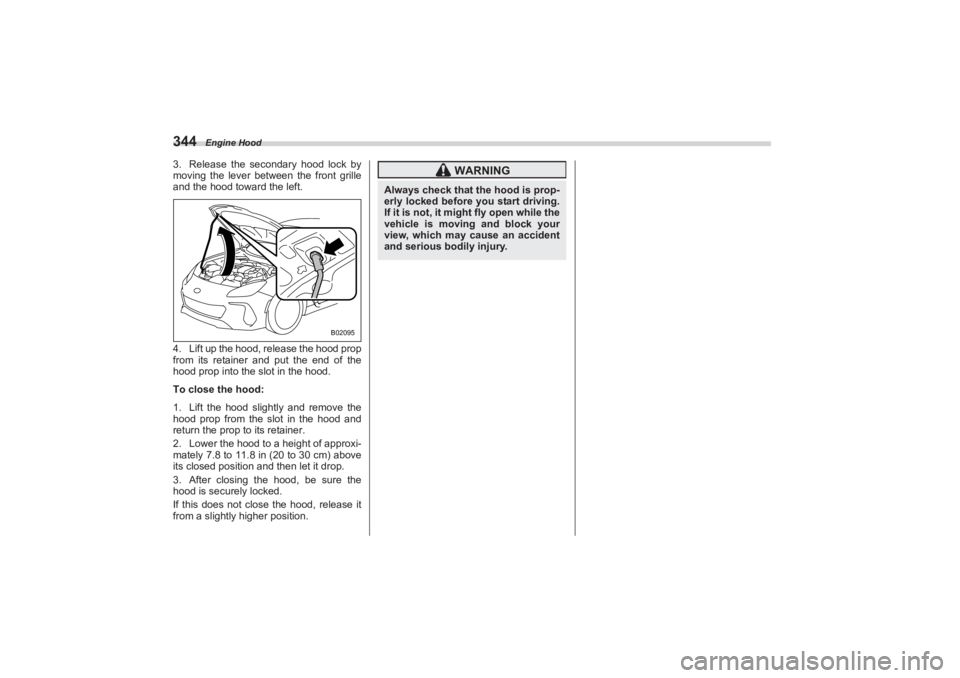
Engine Hood
3443. Release the secondary hood lock by
moving the lever between the front grille
and the hood toward the left.
4. Lift up the hood, release the hood prop
from its retainer and put the end of the
hood prop into the slot in the hood.
To close the hood:
1. Lift the hood slightly and remove the
hood prop from the slot in the hood and
return the prop to its retainer.
2. Lower the hood to a height of approxi-
mately 7.8 to 11.8 in (20 to 30 cm) above
its closed position and then let it drop.
3. After closing the hood, be sure the
hood is securely locked.
If this does not close the hood, release it
from a slightly higher position.
B02095
WARNING
Always check that the hood is prop-
erly locked before you start driving.
If it is not, it might fly open while the
vehicle is moving and block your
view, which may cause an accident
and serious bodily injury.
BRZ_U.book 344 ページ 2022年3月29日 火曜日 午後3時59分
Page 363 of 432
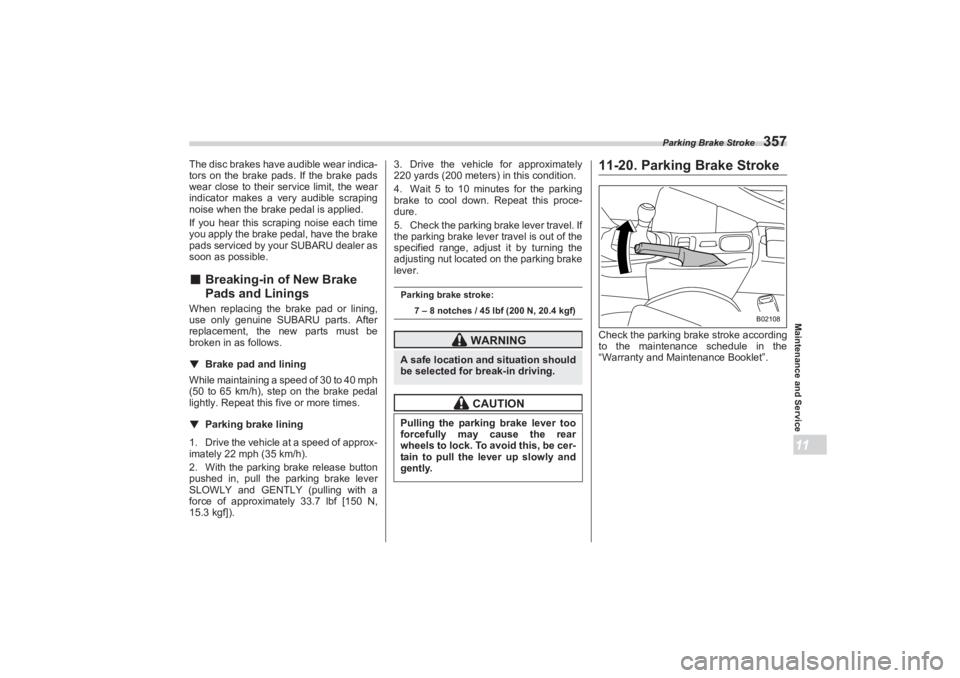
Parking Brake Stroke
357
Maintenance and Service11
The disc brakes have audible wear indica-
tors on the brake pads. If the brake pads
wear close to their service limit, the wear
indicator makes a very audible scraping
noise when the brake pedal is applied.
If you hear this scraping noise each time
you apply the brake pedal, have the brake
pads serviced by your SUBARU dealer as
soon as possible.■ Breaking-in of New Brake
Pad s and LiningsWhen replacing the brake pad or lining,
use only genuine SUBARU parts. After
replacement, the new parts must be
broken in as follows.
▼ Brake pad and lining
While maintaining a speed of 30 to 40 mph
(5 0 to 65 km/h), step on the brake pedal
lightly. Repeat this five or more times.
▼ Parking brake lining1. Drive the vehicle at a speed of approx-
imately 22 mph (35 km/h).
2. With the parking brake release button
pushed in, pull the parking brake lever
SLOWLY and GENTLY (pulling with a
force of approximately 33.7 lbf [150 N,
15.3 kgf]). 3. Drive the vehicle for approximately
220 yards (200 meters) in this condition.
4. Wait 5 to 10 minutes for the parking
brake to cool down. Repeat this proce-
dure.
5. Check the parking brake lever travel. If
the parking brake lever travel is out of the
specified range, adjust it by turning the
adjusting nut located on the parking brake
lever.
11-20. Parking Brake StrokeCheck the parking brak e stroke according
to the maintenance schedule in the
“Warranty and Maintenance Booklet”.
Parking brake stroke:
7 – 8 notches / 45 lbf (200 N, 20.4 kgf)
WARNING
A safe location and situation should
be selected for break-in driving.
CAUTION
Pulling the parking brake lever too
forcefully may cause the rear
wheels to lock. To avoid this, be cer-
tain to pull the lever up slowly and
gently.
B02108
BRZ_U.book 357 ページ 2022年3月29日 火曜日 午後3時59分
Page 364 of 432

Tires and Wheels
35811-21. Tires and Wheels■Types of TiresYou should be familiar with type of tires
present on your vehicle.
▼ Summer tires
The factory-installed tires on your new
vehicle are summer tires.
Summer tires are high-speed capability
tires best suited for highway driving under
dry conditions.
Summer tires are inadequate for driving
on slippery roads such as on snow-
covered or icy roads.
If you drive your vehicle on snow-covered
or icy roads, we strongly recommend the
use of winter (snow) tires.
When installing winter tires, be sure to
replace all four tires.
▼ All season tires
All season tires are designed to provide
an adequate measure of traction, handling
and braking performance in year-round
driving including snowy and icy road
conditions. However all season tires do
not offer as much traction performance as
winter (snow) tires in heavy or loose snow
or on icy roads. All season tires are identified by “ALL
SEASON” and/or “M+S” (Mud & Snow) on
the tire sidewall.
▼ Winter (snow) tires
Winter tires are best suited for driving on
snow-covered and icy roads. However
winter tires do not perform as well as
summer tires and all season tires on roads
other than snow-covered and icy roads.
NOTEIf the tread wears down below 0.16 in.
(4mm) on snow tires the effectiveness
of snow tires is lost.
▼ Low profile tires
Generally, low profile tires will wear more
rapidly and tire grip performance will be
reduced on snowy and/or icy roads when
compared to standard tires. Be sure to
use snow tires or tire chains on snowy
and/or icy roads and drive carefully at a
speed appropriate for road and weather
conditions.NOTELow profile tires may cause greater
damage than usual to the wheel when
receiving impact from the road sur-
face. Therefore pay attention to the fol-
lowing:
Be sure to use proper tire inflation
pressure. If tires are under-inflated,
they may be damaged more severely.
Avoid pot holes, uneven pavement,
curbs and other road hazards. Failure
to do so may lead to severe tire and
wheel damage.
■ Tire Pressure Monitoring
System (TPMS) (If Equipped)The tire pressure monitoring system
provides the driver with a warning
message by sending a signal from a
sensor that is installed in each wheel
when tire pressure is severely low. The
tire pressure monitoring system will acti-
vate only when the vehicle is driven. Also,
this system may not react immediately to
a sudden drop in tire pressure (for
example, a blow-out caused by running
over a sharp object).
If you adjust the tire pressures in a warm
garage and will then drive the vehicle in
cold outside air, the resulting drop in tire
pressures may cause the low tire pressure
warning light to illuminate. To avoid this
problem when adjusting the tire pressures
in a warm garage, inflate the tires to pres-
sures higher than those shown on the tire
inflation pressure label. Specifically,
inflate them by an extra 1 psi (6.9 kPa,
0.07 kgf/cm
2) for every difference of 10°F
BRZ_U.book 358 ページ 2022年3月29日 火曜日 午後3時59分